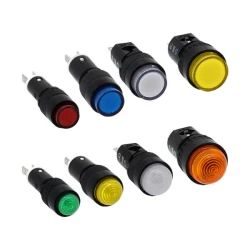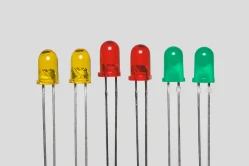Lighting
Lighting in electrical enclosures and industrial settings is crucial for both safety and efficiency. In environments where electrical systems, machines, and panels are operated or maintained, proper lighting ensures that everything is visible, allowing workers to do their jobs effectively and safely. We want to make sure you are using the right light for the job.
At Control Design Supply, we have an understanding of how panel lighting should look and work. We are here as a resource to you to make sure that your project is well lit, so please reach out with any questions or concerns that you might have about your enclosure.
Lighting within Enclosures: Purpose, Advantages, and Setup
- Purpose and Importance: Enclosure lighting is essential for providing adequate visibility inside electrical cabinets, control panels, and other industrial enclosures. This is crucial for maintenance, troubleshooting, and ensuring safe operations.
- LED Advancements: LED technology has revolutionized enclosure lighting. LEDs offer several advantages over traditional lighting solutions, such as longer life spans, lower energy consumption, reduced heat output, and more compact designs.
- Smart Features: Modern enclosure lighting systems often include smart features like motion sensors, which automatically turn the light on when the enclosure is opened. This not only saves energy but also enhances user convenience.
- Installation and Positioning: The effectiveness of enclosure lighting depends on proper installation and positioning. Lighting should be strategically placed to eliminate shadows and provide uniform illumination throughout the enclosure.
- Durability and Safety Standards: Enclosure lights must be durable and often need to comply with specific safety standards, especially in environments that are prone to vibration, dust, and moisture.
Factors to Consider When Choosing Lighting
When selecting lighting for electrical enclosures or industrial environments, several factors come into play:- Power Consumption: With rising energy costs and sustainability efforts, choosing energy-efficient lighting options like LEDs is becoming the standard.
- Environment: The lighting needs to be appropriate for the environment. For example, an enclosure exposed to moisture or dust may require moisture-resistant and sealed lights.
- Durability: Industrial settings often involve harsh conditions. Lighting in these environments must be durable enough to withstand vibrations, temperature fluctuations, and potentially hazardous substances.
- Compliance: Lighting in industrial settings must often meet specific regulations or standards, such as OSHA guidelines for workplace safety or NEC codes for electrical installations.
What is Indicator Lighting?
Indicator lighting consists of lights that change colors or blink to communicate specific information about a machine, system, or process. These lights are usually part of a control panel, piece of equipment, or electrical enclosure, providing immediate visual feedback to workers or operators.The colors and patterns of the indicator lights are often standardized to mean specific things, such as a green light indicating normal operation, a red light signaling an error or warning, or a yellow light denoting a cautionary status. They’re often seen in places where quick decisions or responses are necessary, like manufacturing plants, control rooms, or emergency systems.
Common Uses of Indicator Lighting
- Status Indication: One of the primary uses of indicator lighting is to show the operational status of a system or machine. For example:
- Green Lights: These typically indicate that everything is functioning as expected. A green light on a control panel often means a machine is running or a system is in a “safe” state.
- Red Lights: Red usually signals an error, fault, or danger. It can indicate that a machine is malfunctioning, a system is in a critical state, or a process is halted.
- Yellow/Amber Lights: Yellow lights are often used to indicate warnings, such as a system running in an abnormal state or requiring attention but not yet being in a critical condition.
- Process Monitoring: In industrial applications, indicator lights are used to monitor various processes in real-time. For example, an indicator light might signal that a pump is running, that a temperature is within safe limits, or that a conveyor belt is moving.
- Alarms and Alerts: Many systems use flashing or blinking indicator lights as part of an alarm system. A flashing red light, for instance, may indicate that immediate action is required, such as stopping a machine or addressing a safety issue. Some systems combine the indicator light with sound alarms for even clearer alerts.
- Machine Control Panels: In control panels for machinery or automated systems, indicator lights are an integral part of the interface. These lights show whether a motor, pump, or other component is functioning properly, giving operators immediate feedback and allowing them to make informed decisions.
- Emergency Lighting: Indicator lights are often found as part of emergency systems in buildings, especially in areas like fire safety. For example, exit signs and emergency lights with indicators show escape routes, ensuring that people can easily identify them in an emergency.
What Are Stackable Tower Lights?
A stackable tower light consists of a series of light modules stacked vertically, each emitting a different color. Each color or combination of colors in the stack typically represents a specific operational status, such as "running," "warning," or "fault." These lights are modular, meaning additional light segments can be stacked together, allowing customization in terms of height and the number of color signals needed for a particular application.Where Are Stackable Tower Lights Used?
- Manufacturing and Assembly Lines: In environments with continuous or automated production processes, stackable tower lights give operators immediate visual cues about the status of machinery, helping to quickly identify any issues.
- Material Handling and Logistics: Forklifts, conveyors, and sorting systems often use stackable lights to communicate system status—whether the system is running, whether there’s a blockage, or if it needs maintenance.
- Control Rooms: Tower lights are used in control rooms to show the status of systems and processes, especially when there is a need for operators to monitor multiple systems at once.
- Warehouses: In warehouses with complex inventory or order-picking systems, stackable lights can help direct workers, indicate when an area is cleared or obstructed, or show when equipment needs maintenance.
Order Your Lighting from CDS Today!
With over five decades of industry experience, we are a trusted and leading supplier of electronic components. Our large inventory of electrical products is designed to provide solutions for every industry. In addition to top-quality electrical components, we offer comprehensive kitting, assembly, and customization services to meet your exact needs. No matter your project or specifications, you can find the right solution at CDS.Contact us to learn more about our products and services and speak with a knowledgeable team member. Request a quote to get started on your order today.





